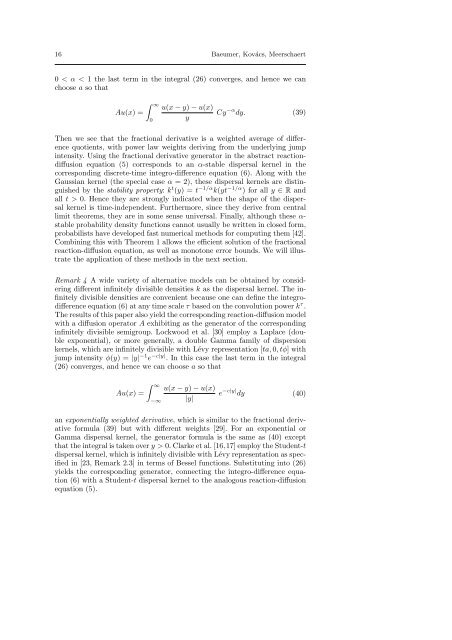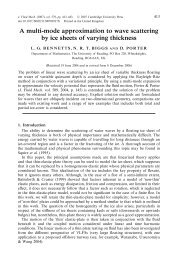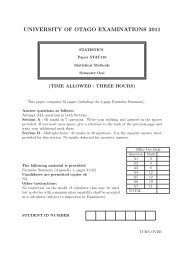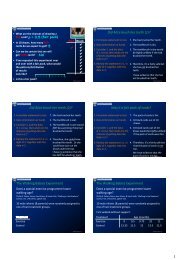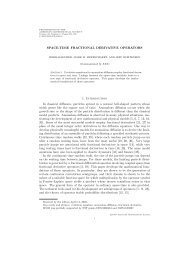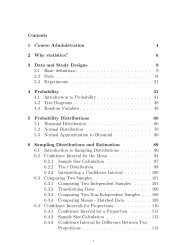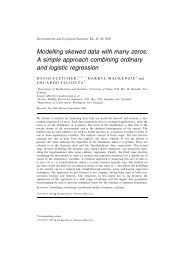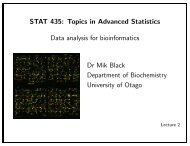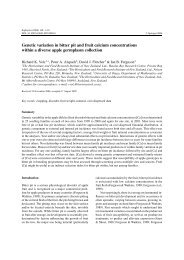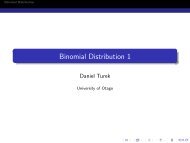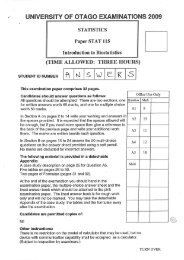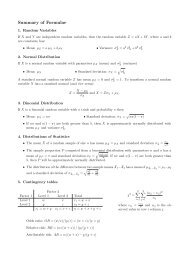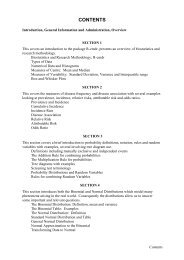Fractional reaction-diffusion equation for species ... - ResearchGate
Fractional reaction-diffusion equation for species ... - ResearchGate
Fractional reaction-diffusion equation for species ... - ResearchGate
Create successful ePaper yourself
Turn your PDF publications into a flip-book with our unique Google optimized e-Paper software.
16 Baeumer, Kovács, Meerschaert<br />
0 < α < 1 the last term in the integral (26) converges, and hence we can<br />
choose a so that<br />
Au(x) =<br />
∫ ∞<br />
0<br />
u(x − y) − u(x)<br />
y<br />
Cy −α dy. (39)<br />
Then we see that the fractional derivative is a weighted average of difference<br />
quotients, with power law weights deriving from the underlying jump<br />
intensity. Using the fractional derivative generator in the abstract <strong>reaction</strong><strong>diffusion</strong><br />
<strong>equation</strong> (5) corresponds to an α-stable dispersal kernel in the<br />
corresponding discrete-time integro-difference <strong>equation</strong> (6). Along with the<br />
Gaussian kernel (the special case α = 2), these dispersal kernels are distinguished<br />
by the stability property: k t (y) = t −1/α k(yt −1/α ) <strong>for</strong> all y ∈ R and<br />
all t > 0. Hence they are strongly indicated when the shape of the dispersal<br />
kernel is time-independent. Furthermore, since they derive from central<br />
limit theorems, they are in some sense universal. Finally, although these α-<br />
stable probability density functions cannot usually be written in closed <strong>for</strong>m,<br />
probabilists have developed fast numerical methods <strong>for</strong> computing them [42].<br />
Combining this with Theorem 1 allows the efficient solution of the fractional<br />
<strong>reaction</strong>-<strong>diffusion</strong> <strong>equation</strong>, as well as monotone error bounds. We will illustrate<br />
the application of these methods in the next section.<br />
Remark 4 A wide variety of alternative models can be obtained by considering<br />
different infinitely divisible densities k as the dispersal kernel. The infinitely<br />
divisible densities are convenient because one can define the integrodifference<br />
<strong>equation</strong> (6) at any time scale τ based on the convolution power k τ .<br />
The results of this paper also yield the corresponding <strong>reaction</strong>-<strong>diffusion</strong> model<br />
with a <strong>diffusion</strong> operator A exhibiting as the generator of the corresponding<br />
infinitely divisible semigroup. Lockwood et al. [30] employ a Laplace (double<br />
exponential), or more generally, a double Gamma family of dispersion<br />
kernels, which are infinitely divisible with Lévy representation [ta, 0, tφ] with<br />
jump intensity φ(y) = |y| −1 e −c|y| . In this case the last term in the integral<br />
(26) converges, and hence we can choose a so that<br />
Au(x) =<br />
∫ ∞<br />
−∞<br />
u(x − y) − u(x)<br />
|y|<br />
e −c|y| dy (40)<br />
an exponentially weighted derivative, which is similar to the fractional derivative<br />
<strong>for</strong>mula (39) but with different weights [29]. For an exponential or<br />
Gamma dispersal kernel, the generator <strong>for</strong>mula is the same as (40) except<br />
that the integral is taken over y > 0. Clarke et al. [16,17] employ the Student-t<br />
dispersal kernel, which is infinitely divisible with Lévy representation as specified<br />
in [23, Remark 2.3] in terms of Bessel functions. Substituting into (26)<br />
yields the corresponding generator, connecting the integro-difference <strong>equation</strong><br />
(6) with a Student-t dispersal kernel to the analogous <strong>reaction</strong>-<strong>diffusion</strong><br />
<strong>equation</strong> (5).


